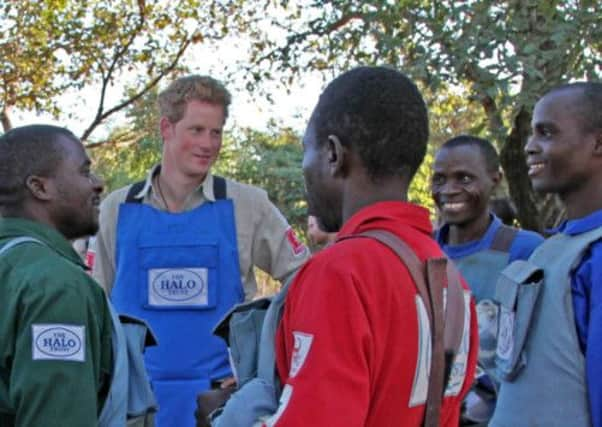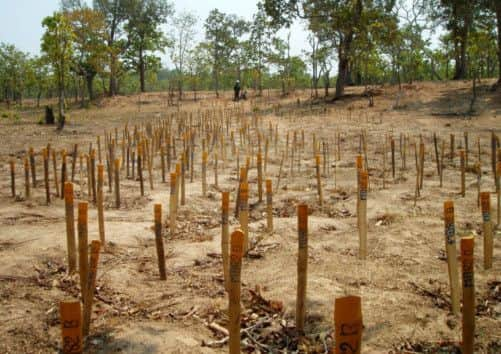HALO Trust: The fight against landmines


Ask Guy Willoughby what he’d love to do and he’ll tell you it’s to retire and farm sheep. And the only thing that’s stopping him doing so now? Just the matter of ridding the world of all landmines. Give him another ten years, he reckons, and he’ll have achieved it. Willoughby is a man of vision. He is also a man who succeeds in his aims.
“Landmines don’t have sex, they don’t breed and once you’ve got rid of landmines they’ve gone for good, so it’s something achievable,” says the ex-army captain who is chief executive of the HALO Trust, the world’s oldest and largest humanitarian landmine clearance organisation.
Advertisement
Hide AdAdvertisement
Hide AdIt’s now 25 years since he and Colin ‘Mad Mitch’ Mitchell formed HALO, after seeing the devastating effects of landmines in Afghanistan and Cambodia. “No-one else was doing it. There were millions of refugees wanting to go back to Afghanistan and Cambodia and nobody else was doing anything to clear the mines,” says Willoughby.


“Landmine casualties were very well known and the Red Cross were saving lives, fitting limbs and providing curative medicine, but nobody was doing the preventative medicine. That’s what we do. When we clear mines, it’s preventative medicine”
Since 1988 the charity, which has its global HQ in a converted stable block in Thornhill, Dumfries and Galloway, has taken on 8,000 full-time staff in 14 countries. They have destroyed more than 1.4m landmines and cleared thousands of miles of roads and hundreds of thousands of acres of land from the hidden weapons, many left over from long-finished conflicts, which still kill, maim and ruin lives across the globe.
This week Prince Harry, Patron of HALO’s 25th Anniversary Appeal, travelled to Washington DC to raise awareness of the organisation of which his mother, the late Princess Diana, was a great supporter. As part of its anniversary celebrations HALO is staging a photographic exhibition in the US city, which the prince visited before meeting a number of Senators to help promote HALO’s efforts. But the anniversary provokes mixed feelings in Willoughby. “When HALO started my aim was to have 5,000 deminers and we have now got 8,000,” he says. “We’ve exceeded my original goal and I am really pleased. It’s good, but, while I don’t want to be negative, 25 years on it’s a slight sign of failure in that if we’d had more deminers earlier we could have cleared more mines. Willoughby adds that his big aim now is to make sure the organisation won’t be still in existence to celebrate its 50th birthday.
“The vast majority of landmines were planted in the 1970s and 1980s. My goal would be to have all landmines across the world cleared in the next ten years. We want to make ourselves redundant as soon as possible.”
The scale of such a task might seem overwhelming, but Willoughby has already envisaged how it can be done. “If we can keep 8,000 deminers working in the next five years we can clear all the landmines in Mozambique, Somalia, Kosovo, Georgia and Sri Lanka. With 10,000 deminers we can clear Afghanistan, Cambodia, Angola, Colombia and Zimbabwe and we will have succeeded and I can finally retire and farm sheep.”
He makes it all sound remarkably prosaic for such an intrinsically dangerous activity. According to Willoughby, it is. “To be successful in mine clearance one needs a lot of people and a lot of determined efforts and one has got to avoid distractions such as conferences. But it’s quite simple,” he says.
It might be “simple”, but such activities still need funding. “At the moment HALO’s annual turnover is £35m a year,” says Willoughby. “If we can increase that to £40m we can make landmines history and we call all stop talking about it. It will be a success for Princess Diana and a success for Prince Harry.” It is, of course, impossible to know how many hundreds of thousands of lives have been saved by HALO’s works. How many children the organisation has saved from being left limbless, blind or maimed. What is known is that each one of the 1.4m landmines which HALO’s mineclearers have removed so far was a potential tragedy waiting to happen.
Advertisement
Hide AdAdvertisement
Hide AdAfter a quarter of a century doing so much to achieve a world without landmines, is there one image in the Washington photo exhibition that represents for Willoughby what HALO does? “There are so many,” he says. “But there’s a photo of an elderly woman, with one leg, going home along a road in Angola. What we’re trying to do is make sure people can go home without risking losing a limb. Make sure they can go home and there are no landmines.”